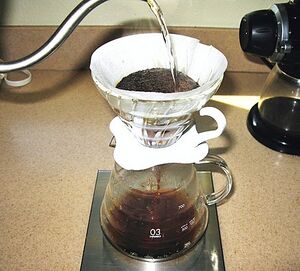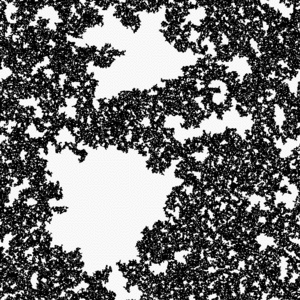渗流
此词条暂由彩云小译翻译,未经人工整理和审校,带来阅读不便,请见谅。

In coffee percolation, soluble compounds leave the coffee grounds and join the water to form coffee. Insoluble compounds (and granulates) remain within the coffee filter.
在咖啡过滤中,可溶性化合物离开咖啡渣并加入水形成咖啡。不溶性化合物(和颗粒)留在咖啡过滤器中。]
Percolation in a square lattice (Click to animate)
In physics, chemistry and materials science, percolation (from Latin percōlāre, "to filter" or "trickle through") refers to the movement and filtering of fluids through porous materials.
In physics, chemistry and materials science, percolation (from Latin percōlāre, "to filter" or "trickle through") refers to the movement and filtering of fluids through porous materials.
在物理、化学和材料科学中, percolation (从拉丁语 percōlāre,“ to filter”或“ trickle through”)指的是流体通过多孔材料的运动和过滤。
It is described by Darcy's law.
It is described by Darcy's law.
这是[[达西定律]]所描述的。
Broader applications have since been developed that cover connectivity of many systems modeled as lattices or graphs, analogous to connectivity of lattice components in the filtration problem that modulates capacity for percolation.
Broader applications have since been developed that cover connectivity of many systems modeled as lattices or graphs, analogous to connectivity of lattice components in the filtration problem that modulates capacity for percolation.
人们已经开发出了更广泛的应用,这些应用覆盖了许多以格子或图为模型的系统的连通性,类似于过滤问题中调节渗流能力的格子组件的连通性。
Background背景
During the last decades, percolation theory, the mathematical study of percolation, has brought new understanding and techniques to a broad range of topics in physics, materials science, complex networks, epidemiology, and other fields. For example, in geology, percolation refers to filtration of water through soil and permeable rocks. The water flows to recharge the groundwater in the water table and aquifers. In places where infiltration basins or septic drain fields are planned to dispose of substantial amounts of water, a percolation test is needed beforehand to determine whether the intended structure is likely to succeed or fail.
During the last decades, percolation theory, the mathematical study of percolation, has brought new understanding and techniques to a broad range of topics in physics, materials science, complex networks, epidemiology, and other fields. For example, in geology, percolation refers to filtration of water through soil and permeable rocks. The water flows to recharge the groundwater in the water table and aquifers. In places where infiltration basins or septic drain fields are planned to dispose of substantial amounts of water, a percolation test is needed beforehand to determine whether the intended structure is likely to succeed or fail.
在过去的几十年里,渗流理论Percolation theory,渗流的数学研究,给物理学、材料科学、复杂网络Percolation theory复杂网络、流行病学和其他领域带来了新的理解和技术。例如,在地质学中,渗滤指的是水通过土壤和渗透性岩石的过滤。这些水流入地下水位和蓄水层补给地下水。在计划排放大量水的渗滤池或化粪池的地方,需要事先进行渗滤试验,以确定预期的结构是否可能成功。
Percolation typically exhibits universality. Statistical physics concepts such as scaling theory, renormalization, phase transition, critical phenomena and fractals are used to characterize percolation properties. Percolation is the downward movement of water through pores and other spaces in the soil due to gravity.
Percolation typically exhibits universality. Statistical physics concepts such as scaling theory, renormalization, phase transition, critical phenomena and fractals are used to characterize percolation properties. Percolation is the downward movement of water through pores and other spaces in the soil due to gravity.
渗滤作用具有典型的普遍性。统计物理概念,如标度理论,重整化,相变,临界现象和分形用于描述渗流特性。渗透是由于重力作用,水通过孔隙和土壤中的其他空间向下运动。
Combinatorics is commonly employed to study percolation thresholds.
Combinatorics is commonly employed to study percolation thresholds.
组合数学是研究渗流阈值的常用方法。
Due to the complexity involved in obtaining exact results from analytical models of percolation, computer simulations are typically used. The current fastest algorithm for percolation was published in 2000 by Mark Newman and Robert Ziff.[1]
Due to the complexity involved in obtaining exact results from analytical models of percolation, computer simulations are typically used. The current fastest algorithm for percolation was published in 2000 by Mark Newman and Robert Ziff.
由于从渗流分析模型获得精确结果所涉及的复杂性,通常使用计算机模拟。目前最快的逾渗算法是由马克 · 纽曼和罗伯特 · 齐夫在2000年发表的。
Examples实例
- Coffee percolation, where the solvent is water, the permeable substance is the coffee grounds, and the soluble constituents are the chemical compounds that give coffee its color, taste, and aroma.
- Movement of weathered material down on a slope under the earth's surface.
- Cracking of trees with the presence of two conditions, sunlight and under the influence of pressure.
- Collapse and robustness of biological virus shells to random subunit removal (experimentally verified fragmentation and disassembly of viruses).[2][3]
- Robustness of networks to random and targeted attacks.[4]
- Transport in porous media.
- Surface roughening.[citation needed]
- Dental percolation, increase rate of decay under crowns because of a conducive environment for strep mutants and lactobacillus
- Potential sites for septic systems are tested by the "perk test". Example/theory: A hole (usually 6–10 inches in diameter) is dug in the ground surface (usually 12–24" deep). Water is filled in to the hole, and the time is measured for a drop of one inch in the water surface. If the water surface quickly drops, as usually seen in poorly-graded sands, then it is a potentially good place for a septic "leach field". If the hydraulic conductivity of the site is low (usually in clayey and loamy soils), then the site is undesirable.
- Traffic percolation.[7]
See also参见
References
- ↑ Newman, Mark; Ziff, Robert (2000). "Efficient Monte Carlo Algorithm and High-Precision Results for Percolation". Physical Review Letters. 85 (19): 4104–4107. arXiv:cond-mat/0005264. Bibcode:2000PhRvL..85.4104N. CiteSeerX 10.1.1.310.4632. doi:10.1103/PhysRevLett.85.4104. PMID 11056635.
- ↑ Brunk, Nicholas E.; Lee, Lye Siang; Glazier, James A.; Butske, William; Zlotnick, Adam (2018). "Molecular jenga: The percolation phase transition (collapse) in virus capsids". Physical Biology. 15 (5): 056005. Bibcode:2018PhBio..15e6005B. doi:10.1088/1478-3975/aac194. PMC 6004236. PMID 29714713.
- ↑ Lee, Lye Siang; Brunk, Nicholas; Haywood, Daniel G.; Keifer, David; Pierson, Elizabeth; Kondylis, Panagiotis; Wang, Joseph Che-Yen; Jacobson, Stephen C.; Jarrold, Martin F.; Zlotnick, Adam (2017). "A molecular breadboard: Removal and replacement of subunits in a hepatitis B virus capsid". Protein Science. 26 (11): 2170–2180. doi:10.1002/pro.3265. PMC 5654856. PMID 28795465.
- ↑ R. Cohen and S. Havlin (2010). "Complex Networks: Structure, Robustness and Function". Cambridge University Press.
- ↑ Parshani, Roni; Carmi, Shai; Havlin, Shlomo (2010). "Epidemic Threshold for the Susceptible-Infectious-Susceptible Model on Random Networks". Physical Review Letters. 104 (25): 258701. arXiv:0909.3811. Bibcode:2010PhRvL.104y8701P. doi:10.1103/PhysRevLett.104.258701. ISSN 0031-9007. PMID 20867419.
- ↑ Grassberger, Peter (1983). "On the Critical Behavior of the General Epidemic Process and Dynamical Percolation". Mathematical Biosciences. 63 (2): 157–172. doi:10.1016/0025-5564(82)90036-0.
- ↑ D. Li, B. Fu, Y. Wang, G. Lu, Y. Berezin, H.E. Stanley, S. Havlin (2015). "Percolation transition in dynamical traffic network with evolving critical bottlenecks". PNAS. 112 (3): 669–72. Bibcode:2015PNAS..112..669L. doi:10.1073/pnas.1419185112. PMC 4311803. PMID 25552558.
{{cite journal}}: CS1 maint: multiple names: authors list (link)
Further reading
- Kesten, Harry; "What is percolation?", in Notices of the AMS, May 2006.
- Sahimi, Muhammad; Applications of Percolation Theory, Taylor & Francis, 1994. (cloth), (paper).
- Grimmett, Geoffrey; Percolation (2. ed). Springer Verlag, 1999.
- Stauffer, Dietrich ; and Aharony, Ammon; Introduction to Percolation Theory, Taylor & Francis, 1994, revised second edition, .
- Bunde, Armin; Havlin, Shlomo (editors); Fractals and Disordered Systems, Springer, 1996.
- Kirkpatrick, Scott; "Percolation and Conduction", in Reviews of Modern Physics, 45, 574, 1973.
- Ben-Avraham, Daniel; Havlin, Shlomo; Diffusion and Reactions in Fractals and Disordered Systems, Cambridge University Press, 2000.
- Rodrigues, Edouard; Remarkable properties of pawns on a hexboard
- Cohen, Reuven; and Havlin, Shlomo; Complex Networks: Structure, Robustness and Function, Cambridge University Press, 2010, .
- Bollobás, Béla; Riordan, Oliver; Percolation, Cambridge University Press, 2006, .
- Grimmett, Geoffrey; Percolation, Springer, 1999
External links
Category:Systems theory
范畴: 系统论
Category:Combinatorics
分类: 组合数学
This page was moved from wikipedia:en:Percolation. Its edit history can be viewed at 渗流/edithistory
- Bollobás, Béla; Riordan, Oliver; Percolation, Cambridge University Press, 2006, .
- CS1 maint: multiple names: authors list
- Articles with hatnote templates targeting a nonexistent page
- All articles with unsourced statements
- Articles with unsourced statements from October 2014
- Articles with invalid date parameter in template
- AC with 0 elements
- Pages with red-linked authority control categories
- Systems theory
- Combinatorics
- 待整理页面
